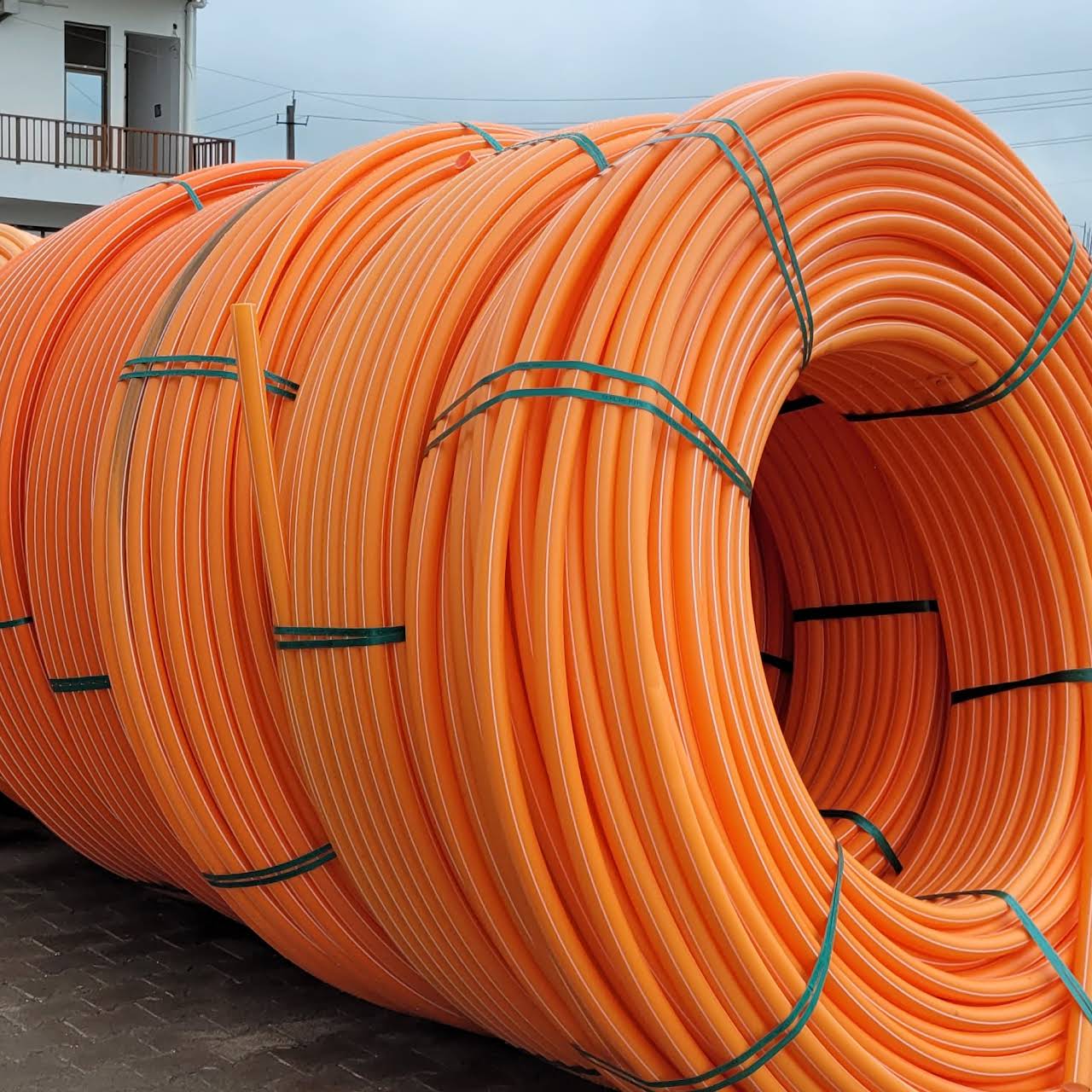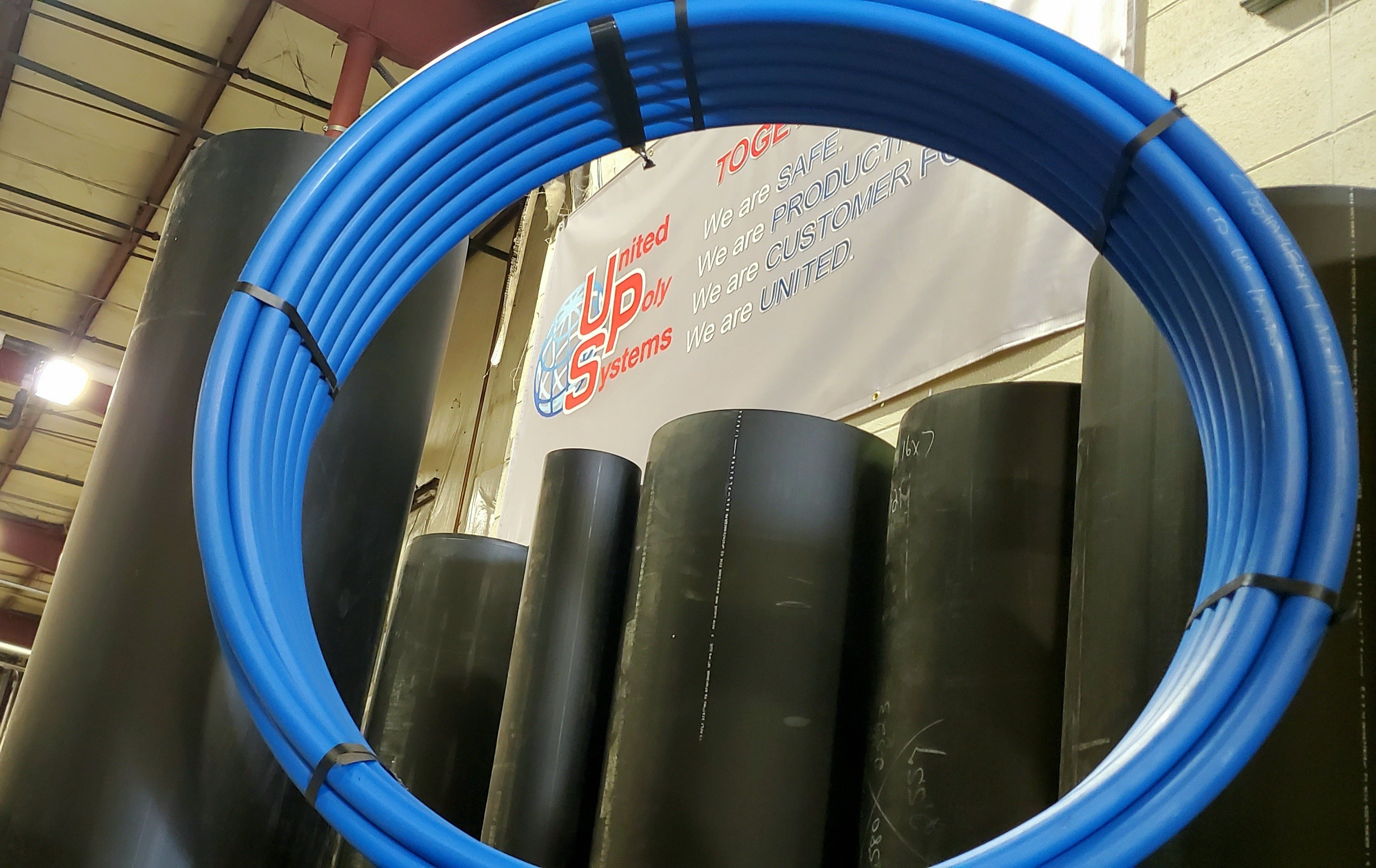hdpe pipe suppliers Midland TX: Selection Guide for Contractors
Check Out the Manufacturing Refine Behind High-Quality HDPE Pipeline and Its Applications
The manufacturing process of top quality HDPE pipelines is complex and systematic. It starts with the selection of raw materials that boost efficiency. Following this, ethylene goes through polymerization to form resin, which is after that shaped via extrusion. Quality control is extremely important, guaranteeing that the end product satisfies strict criteria. Nevertheless, the journey of HDPE pipelines doesn't finish with manufacturing. Their applications throughout numerous sectors expose a more comprehensive relevance worth checking out.
Recognizing HDPE: Properties and Advantages

High-density polyethylene (HDPE) is a functional thermoplastic understood for its durability and resistance to numerous ecological variables. This material shows superb tensile strength, making it ideal for requiring applications. Its low-density structure adds to a lightweight product, assisting in simplicity of dealing with and installment. HDPE additionally showcases exceptional resistance to chemicals, which decreases deterioration when subjected to extreme materials.
The material's reduced moisture absorption better improves its long life, making it perfect for usage in pipelines and storage space tanks. Additionally, HDPE is resistant to ultraviolet (UV) radiation, making sure that items preserve their stability also when exposed to sunlight. Its versatility permits for the creation of complex shapes without compromising toughness. The environmentally friendly nature of HDPE, typically originated from recycled materials, includes in its appeal, promoting lasting methods in production. Overall, these residential or commercial properties and benefits make HDPE a favored option for numerous commercial and customer applications.
Raw Product Selection for HDPE Manufacturing
The choice of raw products for HDPE production is essential to validate the last product meets the preferred requirements and top quality standards. High-density polyethylene (HDPE) is mainly generated from polymerized ethylene, stemmed from nonrenewable fuel sources such as natural gas or crude oil. The high quality of these feedstocks greatly affects the mechanical and thermal residential properties of the final HDPE.
Additives also play a substantial role in enhancing HDPE's performance, consisting of antioxidants, UV stabilizers, and colorants, which enhance sturdiness and resistance to ecological factors. The choice procedure have to take into consideration not only the chemical composition of the raw products but also their processing qualities to assure efficient manufacturing.
The sourcing of raw products must focus on sustainability and compliance with ecological policies, as liable techniques are crucial in today's market. Ultimately, careful resources choice lays the foundation for producing high-grade HDPE pipelines suitable for diverse applications.
The Extrusion Process: Forming HDPE Pipeline
The extrusion procedure plays a crucial function fit HDPE pipes, beginning with meticulous product preparation techniques that assure perfect circulation and uniformity. Similarly essential is the style of the die, which directly influences the final dimensions and surface quality of the pipeline. With each other, these aspects add significantly to the efficiency and quality of HDPE pipeline production.
Material Prep Work Techniques
Effective manufacturing of HDPE pipes begins with careful material preparation strategies, particularly the extrusion procedure. Throughout this phase, high-density polyethylene resin is very first dried out to get rid of moisture, guaranteeing perfect circulation features. The material is after that fed into the extruder, where it goes through heating and melting, transforming right into a viscous state. This heating procedure is meticulously controlled to maintain the product's integrity and performance. The molten HDPE is compelled through a die, shaping it right into a continuous pipe kind. Correct temperature administration throughout extrusion is crucial, as it directly affects the product's buildings and the end product high quality. As soon as formed, the HDPE pipe is cooled and reduced to defined sizes, ready for subsequent handling and applications.
Die Style Value
Accuracy in die style plays a crucial role in the extrusion procedure of HDPE pipelines. The die functions as the last shaping tool, straight affecting the pipeline's measurements, wall surface thickness, and surface coating. A properly designed die assurances consistent material flow, reducing problems such as abnormalities and weak points. The geometry of the die have to be maximized to suit the specific residential or commercial properties of HDPE, including its viscosity and thermal habits during extrusion. Furthermore, the cooling rate of the material as it passes via the die can considerably influence the pipeline's structural honesty. Consequently, spending in sophisticated die modern technology is essential for manufacturers intending to generate top quality HDPE pipes that satisfy sector requirements and client assumptions.
High Quality Control Steps in HDPE Production
Different factors affect the quality of HDPE pipeline production, efficient high quality control steps are important to assure uniformity and dependability in the last product (hdpe pipe in stock Midland TX). Trick quality assurance techniques consist of extensive product inspection, confirming that the raw polyethylene meets well-known requirements for pureness and thickness. Throughout the extrusion process, criteria such as temperature level, stress, and cooling time are very closely these details checked to maintain dimensional precision and architectural stability
On top of that, post-production screening is necessary; makers frequently carry out hydrostatic examinations to examine the pipeline's strength and resistance to stress. Aesthetic inspections for surface issues even more boost high quality assurance. Accreditation from pertinent standards organizations, like ASTM or ISO, supplies an extra layer of reputation. By executing these detailed quality assurance steps, suppliers can reduce defects, boost efficiency, and ensure that the HDPE pipes fulfill the particular needs of different applications, ultimately causing customer complete satisfaction and count on the item.
Applications of HDPE Pipeline Across Industries
HDPE pipes are used throughout different sectors as a result of their durability and versatility. In water distribution systems, they ensure effective distribution, while in wastewater management, they offer trustworthy solutions for waste transport. In addition, farming irrigation networks gain from HDPE's resistance to corrosion and adaptability, making it a perfect choice for contemporary farming methods.

Water Circulation Solutions
A considerable variety of markets count on high-density polyethylene (HDPE) pipelines for reliable water distribution systems. Understood for their durability and resistance to rust, HDPE pipelines are widely used in community water supply networks, agricultural watering, and industrial applications. Their light-weight nature promotes very easy handling and setup, minimizing labor prices and time. Furthermore, HDPE pipelines can accommodate various stress levels, making them suitable for both reduced and high-pressure systems. hdpe pipe suppliers Midland TX. The versatility of the material enables for smooth integration into existing facilities, lessening the demand for considerable excavation. Moreover, HDPE's resistance to chemical leaching assurances that the water delivered stays secure and tidy, making it an excellent selection for preserving the top quality of drinkable water throughout various sectors
Wastewater Administration Solutions
Efficient water distribution systems additionally lead the means for innovative wastewater monitoring services, where high-density polyethylene (HDPE) pipelines play a considerable duty. Popular for their resilience and resistance to rust, HDPE pipes are optimal for moving wastewater in numerous setups. Their adaptability allows for simple installment in complex environments, decreasing the need for comprehensive excavation. Additionally, HDPE's smooth indoor surface minimizes rubbing, enhancing circulation prices and efficiency. These pipes are additionally resistant to chemical leaching, guaranteeing that pollutants do not endanger the surrounding atmosphere. Industries, towns, and treatment facilities progressively rely on HDPE pipelines for their reliability and durability, making them a preferred choice see this page for contemporary wastewater monitoring systems. This flexibility emphasizes the essential value of HDPE pipelines across many applications.
Agricultural Irrigation Networks
Agricultural watering networks benefit greatly from the use of high-density polyethylene (HDPE) pipelines, which give efficient and trusted water delivery to crops. HDPE pipes are light-weight, making them easy to deliver and mount, while their adaptability enables for various configurations in diverse terrains. These pipelines show exceptional resistance to rust, chemicals, and UV radiation, making certain longevity in extreme farming settings. Additionally, their smooth indoor surface area minimizes rubbing loss, optimizing water flow and lowering power costs connected with pumping. The durability of HDPE pipes, often going beyond half a century, adds to decrease maintenance and replacement expenditures. Farmers increasingly rely on HDPE pipes to enhance watering efficiency and advertise sustainable agricultural methods, ultimately leading to boosted crop returns and resource preservation.

Future Patterns in HDPE Pipeline Technology
As the demand for lasting and effective framework grows, advancements in HDPE pipe technology are positioned to change various sectors. Arising patterns consist of the integration of wise modern technologies, such as sensing units and IoT abilities, which assist in real-time tracking of pipe problems, reducing upkeep expenses and stopping leakages. Additionally, the advancement of advanced production strategies, such as 3D printing, is enabling the production of complicated, tailored pipeline designs that deal with certain project demands.
The emphasis on recycling and round economic climate techniques is driving the advancement of HDPE pipes made from recycled products, improving sustainability. Boosted jointing techniques, such as electro-fusion and mechanical installations, are also boosting setup effectiveness and reliability. The growing emphasis on ecological regulations is pushing manufacturers to take on greener production processes, making certain that HDPE pipelines not just fulfill industry standards yet also promote a more lasting future for framework growth.
Often Asked Inquiries
How Does HDPE Compare to Other Plastic Materials?
HDPE outmatches numerous other plastic products relating to sturdiness, chemical resistance, and adaptability. Its low density and high tensile strength make it excellent for different applications, often surpassing options in both performance and durability.
What Are the Ecological Impacts of HDPE Production?
The environmental influences of HDPE manufacturing consist of greenhouse gas discharges, power consumption, and possible pollution from manufacturing processes. In addition, improper disposal can cause soil and water water pipe replacement contamination, increasing issues regarding long-lasting environmental effects.
Can HDPE Pipes Be Reused?
Yes, HDPE pipelines can be reused. Several facilities approve made use of HDPE for handling, transforming it right into brand-new products. This reusing contributes to sustainability initiatives, lowering plastic waste while preserving resources and energy in the production cycle.
What Is the Lifespan of HDPE Pipeline?

Exactly How Do Temperature Level Variations Affect HDPE Pipeline Efficiency?
Temperature level variations significantly affect HDPE pipe performance, affecting adaptability and toughness. Heats can bring about softening, while reduced temperature levels may create brittleness, inevitably influencing the pipe's toughness and viability for numerous applications in diverse settings.